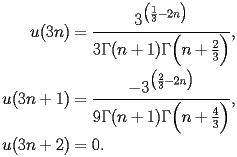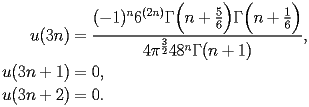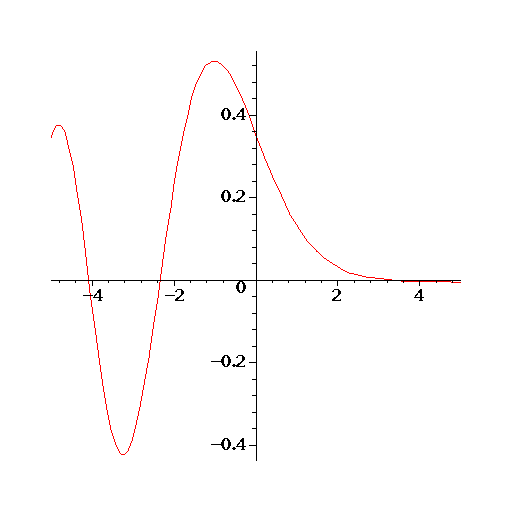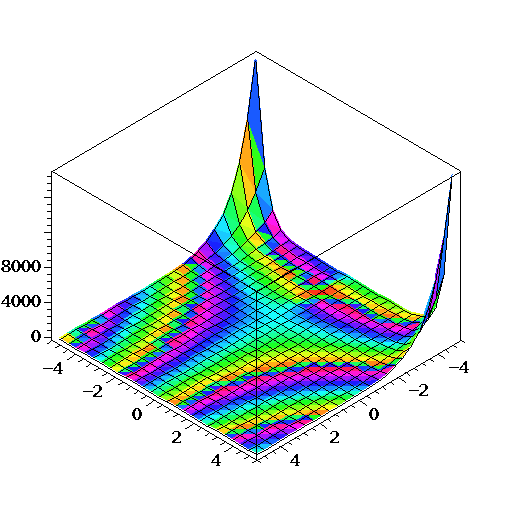AI Airy Ai
AI.1 Introduction |
top up back next into bottom |
Let
 be a complex variable of
be a complex variable of
 .The function Airy Ai (noted
.The function Airy Ai (noted
 ) is defined by the following second order differential equation
) is defined by the following second order differential equation
| AI.1.1 |
The initial conditions of AI.1.1 are given at
 by
by
![\begin{equation*}
\begin{split}
\operatorname{Ai} (0)& =\frac{\sqrt[3]{3}}{3 \Gamma \Bigl(\frac{2}{3}\Bigr)}, \\
\frac{\partial \operatorname{Ai} (x)}{\partial x} (0)& =\frac{-\sqrt[6]{3} \Gamma \Bigl(\frac{2}{3}\Bigr)}{2 \pi}.
\end{split}
\end{equation*}](AI_8.gif)
|
AI.1.2 |
Related function: Airy Bi
AI.2 Series and asymptotic expansions |
top up back next into bottom |
AI.2.1 Taylor expansion at
|
top up back next into bottom |
AI.2.1.2 General form |
top up back next into bottom |

|
AI.2.1.2.1 |
 satisfy the recurrence
satisfy the recurrence
| AI.2.1.2.2 |
| AI.2.1.2.3 |
| AI.2.1.2.4 |




![\begin{equation*}
\begin{split}
\operatorname{Ai} (x)& =\frac{\sqrt[3]{3}}{3 \Gamma \Bigl(\frac{2}{3}\Bigr)} - \frac{\sqrt[6]{3} \Gamma \Bigl(\frac{2}{3}\Bigr)}{2 \pi} x + \frac{\sqrt[3]{3}}{18 \Gamma \Bigl(\frac{2}{3}\Bigr)} x^{3} - \frac{\sqrt[6]{3} \Gamma \Bigl(\frac{2}{3}\Bigr)}{24 \pi} x^{4} + \\
& \quad{}\quad{}\frac{\sqrt[3]{3}}{540 \Gamma \Bigl(\frac{2}{3}\Bigr)} x^{6} - \frac{\sqrt[6]{3} \Gamma \Bigl(\frac{2}{3}\Bigr)}{1008 \pi} x^{7} + \frac{\sqrt[3]{3}}{38880 \Gamma \Bigl(\frac{2}{3}\Bigr)} x^{9} - \frac{\sqrt[6]{3} \Gamma \Bigl(\frac{2}{3}\Bigr)}{90720 \pi} \\
& \quad{}\quad{}x^{10} + \frac{\sqrt[3]{3}}{5132160 \Gamma \Bigl(\frac{2}{3}\Bigr)} x^{12} - \frac{\sqrt[6]{3} \Gamma \Bigl(\frac{2}{3}\Bigr)}{14152320 \pi} x^{13} + \frac{\sqrt[3]{3}}{1077753600 \Gamma \Bigl(\frac{2}{3}\Bigr)} \\
& \quad{}\quad{}x^{15} + \operatorname{O} \bigl(x^{16}\bigr).
\end{split}
\end{equation*}](AI_10.gif)

![\begin{equation*}
\begin{split}
u (0)& =\frac{\sqrt[3]{3}}{3 \Gamma \Bigl(\frac{2}{3}\Bigr)}, \\
u (1)& =\frac{-\sqrt[6]{3} \Gamma \Bigl(\frac{2}{3}\Bigr)}{2 \pi}, \\
u (2)& =0.
\end{split}
\end{equation*}](AI_14.gif)





 The coefficients
The coefficients
 satisfy the following recurrence
satisfy the following recurrence



